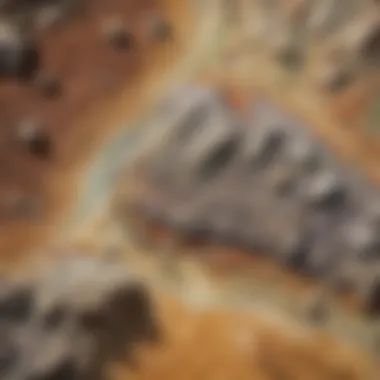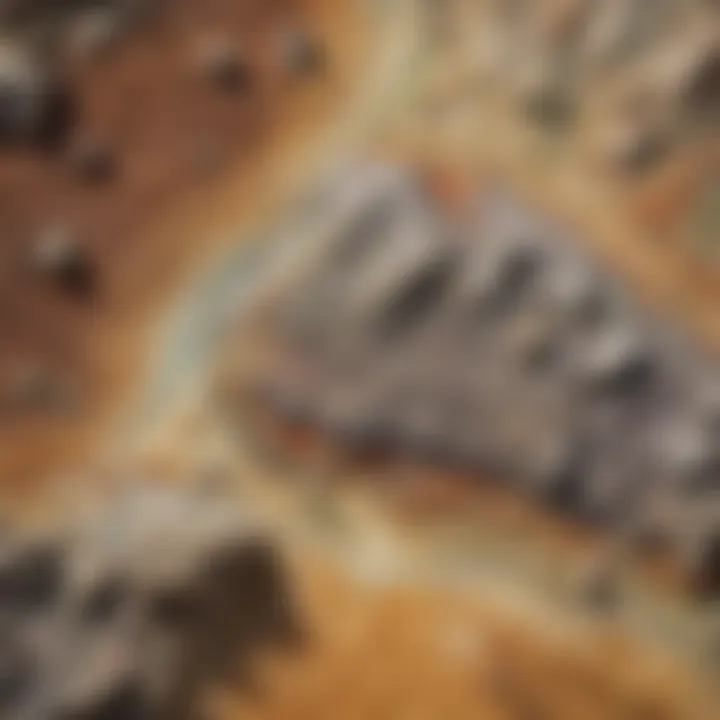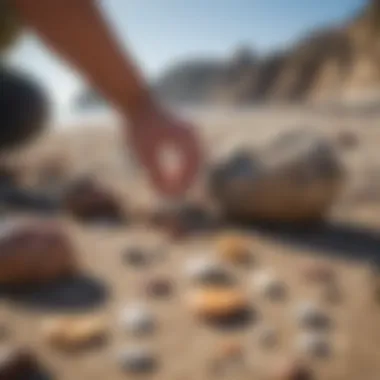Explore and Identify California Beach Rocks


Intro
California's coastline is a treasure trove of geological wonders. The variety of rocks found along the beaches speaks to a rich history of natural processes. From volcanic formations to sedimentary layers, the diversity shapes not only the landscape but also the study and appreciation of geology.
Understanding these beach rocks enhances the experience for collectors and enthusiasts alike. It opens a window into the Earth’s past, showcasing how dynamic nature can be. This guide aims to equip readers with the necessary tools for identifying and appreciating these geological specimens.
Featured Collectible of the Month
Overview
Each month, we will highlight a unique rock specimen found on California's beaches. For this month, we turn our attention to Jadeite, a highly sought-after rock among collectors for its vibrant color and rarity. Found along the California coastline, particularly in regions like Big Sur, jadeite has captivated those with an eye for beauty and uniqueness.
Historical Significance
Jade has played an important role in various cultures. In ancient China, jade was considered more precious than gold. It symbolized purity and moral integrity. Collections of jade artifacts can be traced back thousands of years. In California, the presence of jadeite along the coast has also found its place in local lore and artistry.
"The allure of jadeite is not merely its physical beauty; it's also the connection to human history and culture."
Identification Techniques
Identifying beach rocks can be both rewarding and educational. Here are some key techniques to help you in your endeavor.
Visual Characteristics
- Color: Observe various hues. Rocks often display different shades based on their mineral composition.
- Texture: Touch the surface; is it smooth, rough, or crystalline? This can give clues about its type.
- Luster: How does the rock reflect light? Shininess can indicate the presence of certain minerals.
- Size and Shape: These attributes can distinguish certain categories, such as pebbles, larger boulders, or specific formations.
Resources for Identification
To further assist with identification, utilize the following resources:
- Wikipedia: Rock Types
- Britannica: Geology
- Online forums on Reddit often provide insight and community support.
- Social media groups on Facebook dedicated to rock and fossil collecting can also be valuable for sharing knowledge and experiences.
This guide serves as an initial framework for understanding the rich diversity of California's beach rocks. Each section, from the collectible of the month to specific identification techniques, is designed to foster deeper appreciation and knowledge for enthusiasts and collectors.
Understanding California's Geology
Understanding California's geology is essential for anyone interested in beach rocks. This knowledge serves as a foundation to comprehend how various rocks form and evolve along the coastline. The state has a rich geological history influenced by tectonic activities, erosion processes, and climatic shifts. Each of these elements plays a vital role in the characteristics and distribution of rocks along the beaches.
Geological formations in California reveal much about the Earth’s past. They highlight significant events in the planet's history, such as volcanic eruptions and the movement of tectonic plates. Understanding these factors allows collectors to gain insights into the origins of the rocks they observe. Furthermore, this comprehension enhances the appreciation of the natural environment.
The California coastline is not merely a scenic view but also a dynamic system shaped by continuous processes. Knowing the conditions that lead to coastal erosion and deposition is crucial. It helps in identifying the rock types and their respective features more accurately. Moreover, the impact of climate cannot be overlooked. Different weather patterns influence the types of rock formations found in specific locations.
In summary, a grasp of California’s geological background equips enthusiasts with the necessary context to understand beach rocks better. This insight significantly enriches the experience of collecting and studying these natural specimens.
The Tectonic Background
The tectonic activity in California is a product of the Pacific and North American plates interacting. The region is known for its remarkable geological features and seismic activity. The San Andreas Fault is perhaps the most notable example, as it has shaped the landscape through constant movement.
This tectonic framework contributes to the formation of various rock types found along the coast. For instance, igneous rocks emerge from the cooling of molten lava, while sedimentary rocks form from the accumulation of sediments over time. Knowing where these processes occur helps collectors identify specific rock types found on California's beaches.
Coastal Erosion and Deposition
Coastal erosion is a significant process that shapes the California coastline. It occurs when ocean waves, currents, and winds wear away rocks and sediments. This gradual but relentless process creates new formations and alters existing ones. As rocks are eroded, fragments may be deposited elsewhere, contributing to the sandy beaches prevalent along the coast.
The interaction between erosion and deposition is crucial for rock collectors. Identifying newly exposed rock formations may lead to the discovery of unique specimens. Observing how sediment is transported and where it settles can also provide insight into the geological history of specific areas. Consequently, understanding these processes enhances the overall experience of beachcombing.
The Impact of Climate on Coastal Geology
Climate plays a formidable role in shaping coastal geology. Factors such as temperature, precipitation, and storm patterns can significantly influence the rate of erosion and deposition. For example, heavy rainfall can lead to increased runoff, which may expose different rock types and sediments.
Seasonal changes also affect how rocks are weathered over time. The influence of ocean currents and tides can alter the landscape, revealing or covering rock formations.
For rock collectors, being aware of these climatic influences is beneficial. Knowledge of when to visit certain locations may yield better results in terms of rock visibility and variety. Ultimately, comprehending the interplay between climate and coastal geology enriches the collector's experience, making it more than just a casual hobby.
Classification of Beach Rocks
Understanding the classification of beach rocks is essential for enthusiasts who seek to identify and appreciate the diverse geological features of California's coastline. The classification system serves as a framework to categorize rocks based on their formation processes, composition, and physical characteristics. By learning about the different rock types, individuals can develop a more profound understanding of the coastal environment and enhance their identification skills.
Identifying rocks accurately is crucial not only for aesthetic appreciation but also for educational purposes. Many coastal rocks hold significant scientific and historical relevance. Classifying these rocks allows for systematic study, which contributes to the broader knowledge of geology and ecology. Furthermore, recognizing the characteristics of various rock types can deepen one’s connection to nature and foster a sense of responsibility toward preserving coastal habitats.


Igneous Rocks
Granite
Granite is a prevalent igneous rock found on California's coastline. It is formed from the slow crystallization of magma beneath the earth's surface, resulting in a coarse-grained texture. One key characteristic of granite is its durability, making it an ideal choice for both geological studies and landscaping. The variety of mineral compositions often leads to striking colors and patterns, which enhances its appeal.
In this guide, granite's unique feature is its resistance to weathering, which means it can maintain its structural integrity for long periods. This quality makes granite a reliable choice for collectors who seek robust specimens that will withstand the test of time.
Basalt
Basalt, another significant igneous rock, originates from the rapid cooling of lava at the earth's surface. Its formation process results in a fine-grained structure with a darker hue compared to granite. Basalt is commonly found in coastal regions, often forming from volcanic activity.
A notable characteristic of basalt is its high density, which can be both advantageous and challenging for collectors. Its dense nature allows for a higher mineral content, which can provide insights into volcanic activities in the area. However, this density also makes it less suitable for some collectors who prefer lightweight specimens.
Sedimentary Rocks
Sandstone
Sandstone is a sedimentary rock primarily composed of sand-sized mineral grains, often quartz. It forms through the compaction and cementation of sand deposited in various environments. One of the key attributes of sandstone is its versatility in color and texture, which can vary greatly depending on the composition of the original sand.
This rock type is crucial for this article as it can indicate past environmental conditions. Its unique feature of stratification can provide valuable insights into sedimentary processes at play. However, sandstone may be less durable than igneous rocks, making it important to handle carefully during collection.
Limestone
Limestone is another prominent sedimentary rock found along the California coast. It is primarily composed of calcium carbonate and forms from marine organisms' remains, such as shells and coral. The key characteristic of limestone is its solubility in acidic solutions, which makes it less durable compared to other rock types.
In the context of this article, the significance of limestone lies in its fossiliferous nature. Collectors often seek out limestone for its potential to reveal fossilized remains of ancient life. However, its susceptibility to weathering can be a disadvantage, requiring careful attention when collecting.
Metamorphic Rocks
Schist
Schist is a metamorphic rock characterized by its foliation and mineral composition. This rock typically contains large, visible crystals of mica, allowing it to reflect light and exhibit a shimmering appearance. The formation of schist occurs under high pressure and temperature conditions, altering the original rock into a new texture.
The prominent feature of schist is its distinct banding and layering. This aspect provides an excellent opportunity for enthusiasts to observe geological processes. However, collecting schist can be challenging, as its fragile nature may lead to breakage during transport.
Gneiss
Gneiss is another metamorphic rock recognized for its banded appearance, resulting from the high-grade metamorphism of granite or sedimentary rock. The alternating light and dark mineral bands create a striking visual effect, capturing the interest of collectors.
One key advantage of gneiss in this article is its ability to clearly illustrate the processes of metamorphism. The unique patterns present in gneiss can educate enthusiasts about geological transformations. However, similar to schist, gneiss can also be prone to fracturing, which makes careful handling crucial during collection.
Common Beach Rocks Found in California
Understanding the common beach rocks along California's coastline is vital for enthusiasts and collectors. It allows them to appreciate the diversity of geological formations that have shaped the state over millennia. From granite cliffs to soft sandstone beaches, each type of rock tells a story of environmental changes and geological events.
Recognizing these rocks not only benefits collectors but also contributes to broader ecological awareness. These rocks play essential roles in coastal ecosystems, influencing local habitats and conditions. Therefore, identifying beach rocks can enhance the scientific understanding of coastal processes and sediment transport, further enriching the appreciation of California's natural history.
Types of Granite on the Coast
Granite is a prevalent type of igneous rock found along California's coastal regions. It is known for its durability and coarse-grained texture. Various types of granite can be seen, each with specific features. Common granite types include:
- Sierra Nevada Granite: Found in the eastern part of California, this granite often exhibits a light color with specks of dark mineral grains. It is popular among rock collectors for its striking appearance.
- Coastal Granodiorite: This granite variant is rich in quartz and feldspar, presenting a more varied grain structure. It can be identified by its slightly darker tone compared to traditional granite.
Identifying granite types often involves examining the color and texture. Understanding the local geological history can also guide enthusiasts in recognizing where particular types may be found.
Significance of Sandstone Varieties
Sandstone is another common rock type on California's beaches. It forms from compressed sand grains and comes in various colors and textures. Some notable types of sandstone include:
- Chert: This is a compact sandstone known for its hardness and distinctive look. Often, chert contains fossils, making it significant for paleontologists.
- Quartz Sandstone: A lighter sandstone, often with a high quartz content. The smooth grains make it a popular choice for various construction materials.
Recognizing sandstone varieties can help collectors understand sedimentary processes at work. This knowledge also assists in the preservation of coastal environments by fostering awareness of how human activities can impact these natural formations.
Identification of Unique Limestones
Limestones found along California's coastline are likewise fascinating for collectors. These sedimentary rocks are composed primarily of calcium carbonate and often contain fossils. Various unique limestones can be spotted, such as:
- Marlstone: A type of limestone rich in clay and carbonate, marlstone is often found in coastal rock formations. It has a distinctly softer feel compared to other limestone types.
- Oolitic Limestone: This variety is characterized by small, round grains (ooliths) formed by the accumulation of shell fragments and minerals over time. Its unique texture can make it stand out on the beach.


Identifying limestone varieties enhances understanding of the geological processes responsible for deposition and fossil formation. Furthermore, proactively observing their characteristics helps rock collectors discern between different varieties, enhancing their collecting proficiency.
"In studying coastal geology, one gains insight into the complex interplay between land and sea, underscoring the importance of rock identification in broader ecological contexts."
By reevaluating the common beach rocks, enthusiasts not only refine their collecting practices but also contribute to a deeper appreciation and safeguarding of California's remarkable coastal environment.
The Importance of Beach Rock Identification
Understanding beach rock identification is key for various reasons. It serves not only as a gateway to unraveling geological history but also as a means of fostering appreciation for the natural world. For educators, teaching students about rock types and their formations can significantly enhance learning experiences. For collectors, identifying beach rocks adds value to their specimens and enriches their collections. Ultimately, the knowledge one gains from identifying these rocks shapes our perspective on the environment and its resources.
Scientific Significance
The identification of beach rocks holds profound scientific significance. Each rock tells a story about its formation and the environmental conditions present during its creation. By studying these rocks, scientists can gain insights into the Earth's geological history, past climates, and tectonic activities. This information is vital for understanding natural processes, like erosion and sedimentation, which continually shape coastlines. Moreover, well-identified specimens can contribute to research, aiding in the documentation of changes over time.
Collecting and Preservation Techniques
Collecting beach rocks is more than just finding interesting pieces; it's about doing so responsibly. There are specific techniques to employ to ensure that the collection and preservation of these specimens is mindfully executed.
- Selectively Collect: Always choose minimal quantities, focusing on unique specimens that stand out. This approach reduces the impact on natural habitats.
- Use Proper Tools: A hammer and chisel may be needed for harder rocks, while soft brushes can be used to clean delicate specimens. Ensure you have the right tools for your collection method.
- Document Your Findings: Keep records detailing the location, date, and conditions of your finds. This information provides context, which is beneficial for identification later.
- Storage Conditions: Store collected rocks in a safe environment. Use padded containers to prevent breakage and keep them out of direct sunlight to avoid color fading.
- Preserve Collecting Ethics: Adhere to local laws and regulations about rock collecting. Many areas have restrictions in place for the protection of the ecosystem.
By following these techniques, collectors can ensure that their practices are both ethical and beneficial for future education and study.
Techniques for Identifying Beach Rocks
Understanding how to identify beach rocks is essential for any geology enthusiast or collector. The ability to recognize various rock types not only enhances the appreciation of California's natural beauty but also contributes to science and education. The techniques discussed here provide a strong foundation for accurate rock identification, emphasizing practical methods that can be used in the field.
Visual Inspection Methods
Visual inspection is often the first step in identifying beach rocks. This method involves observing the physical characteristics of the rock without any specialized tools. When examining a rock visually, pay attention to several key features:
- Color: The hue can give clues about the mineral content. For example, granites may display a variety of colors such as pink or gray, while basalt often appears dark.
- Texture: The feel of the rock surface can indicate its type. A rough, granular surface may suggest a sedimentary origin, whereas a glassy surface often indicates an igneous rock.
- Grain Size: Looking closely at the size of the mineral grains can be revealing. Larger grains may indicate a slow cooling process typical of granites, while smaller grains are common in basalts.
Visual inspection is straightforward and requires no tools, making it accessible. However, it might not always provide conclusive results. It is best used in conjunction with other methods for effective identification.
Utilizing Hand Lens for Close Examination
A hand lens or magnifying glass can profoundly affect how you identify rocks. By magnifying the rock surface, a hand lens reveals intricate details that may not be visible with the naked eye. This technique is particularly useful for assessing:
- Mineral Composition: A close view can help identify specific minerals present in the rock. This is especially true for sedimentary rocks where unique grains can be attributed to certain types.
- Foliation and Banding: In metamorphic rocks like schist or gneiss, layering might become more evident under magnification. This detail is crucial for accurate classification.
When using a hand lens, keep it steady and focus on small sections of the rock at a time. This method allows for a more detailed inspection, which can lead to more accurate identifications.
Chemical Tests for Rock Identification
Chemical tests offer a more scientific approach to rock identification. These tests often determine the mineral composition by observing reactions between the rock and certain chemicals. Here are a few basic tests that can be quite effective:
- Acid Test: A drop of hydrochloric acid on limestone produces fizzing due to the release of carbon dioxide. This is a distinguishing feature of calcium carbonate.
- Hardness Test: Using the Mohs scale of hardness, rocks can be tested against common materials like fingernails or glass to gauge their hardness level. This can help differentiate between softer sedimentary rocks and harder igneous rocks.
- Streak Test: Rubbing a rock on a piece of unglazed porcelain can reveal its powder color. This is useful for identifying minerals with varied colors under different conditions.
While chemical tests require additional tools, they can provide invaluable data for rock identification. When utilized alongside visual and magnification methods, they help build a comprehensive profile of each rock type.
Resources for Rock Enthusiasts
Understanding the variety of rocks along California's coast is essential for any geology enthusiast. Resources for rock enthusiasts provide crucial information that enhances the learning experience. The objective of utilizing these resources is to help individuals identify beach rocks accurately, understand their geological significance, and enable responsible collecting practices. The diverse nature of these materials—ranging from books to online databases—offers a comprehensive suite of tools suitable for both beginners and experienced collectors.
Books and Field Guides
Books and field guides are foundational resources that every rock enthusiast should have. They make complex geological concepts accessible and present them in an engaging manner. For example, "California Rocks!" by Marjorie L. Tatum offers rich illustrations and descriptions of various rock types found in the state. These books often include diagnostic features, such as texture, color, and mineral composition, allowing readers to recognize rocks more efficiently in the field.
When selecting a book, it is important to look for publications that include detailed maps and photographs. These visual aids make identification easier, especially when visiting different coastal areas. Field guides often present practical tips on where to find certain rock types, making them indispensable for weekend excursions or serious fieldwork.
Online Databases and Resources
The internet provides a wealth of information that can complement traditional books. Online databases and resources like the U.S. Geological Survey (USGS) and Geology.com offer interactive elements and up-to-date geological data. They facilitate deeper research into local geology and allow enthusiasts to access scientific studies and publications relevant to California's coastal rocks.
Moreover, platforms like Wikipedia offer general overviews on specific rock types, while providing citations for further reading. This method allows enthusiasts to explore topics in greater depth based on reliable sources. Many rock-collecting forums on websites like Reddit encourage discussion and sharing of personal experiences. Engaging with these communities can lead to valuable exchange of tips ranging from identification techniques to responsible collecting practices.
Local Geology Groups and Communities
Joining local geology groups can greatly enhance your understanding of beach rocks. These communities often organize field trips, workshops, and lectures that allow you to connect with knowledgeable individuals. Being part of such groups provides an excellent opportunity for hands-on learning. Participating in group excursions can help you gain practical idenfitication skills that are difficult to achieve alone.


Many local clubs also engage in conservation efforts, emphasizing the importance of ethical collecting. They are instrumental in promoting awareness about legal considerations when collecting rocks. This engagement helps novice collectors navigate the complexities of California's laws regarding rock collection.
Additionally, online platforms such as Facebook have groups dedicated to rock and fossil enthusiasts. These virtual communities can act as both a support network and a source of real-time information about local geological events, conferences, and talks.
Having the right resources and community support can make the difference between simply collecting rocks and truly understanding the geological narratives they tell.
In essence, utilizing books, online resources, and local communities provides a holistic approach to becoming a knowledgeable rock enthusiast. These resources make geological study accessible and promote ethical collection, ensuring that future generations can also enjoy California's fascinating coastal geology.
Challenges in Beach Rock Identification
Understanding the challenges in identifying beach rocks is crucial for collectors and enthusiasts alike. Misidentification can lead to both novice and seasoned geologists misunderstanding the geological history or characteristics of specific rocks. This confusion not only affects personal collections but can also contribute to misinformation within the community. Identifying these rocks accurately enhances one’s appreciation for their formation process and ecological significance.
Misidentification Risks
Misidentification risks arise from several factors. Many rocks share similar physical traits, which can be misleading. For instance, various types of granite can appear similar to the untrained eye, and without proper knowledge, individuals might mistake diorite for granite. This can hinder accurate documentation of sites and mislead studies related to coastal geology.
Additionally, weathering processes can alter the surface appearance of rocks. The natural elements such as erosion, saltwater exposure, and organic growth can obscure original features, complicating identification. Collectors should be cautious and consider factors such as color variations, texture, and grain size before making conclusions.
"Misidentifying rock specimens can obscure geological understanding and lead to flawed interpretations of coastal ecosystems."
To mitigate these risks, enthusiasts should utilize guides and resources that provide detailed comparisons and identification techniques focused on the specific type of rocks found in California.
Variability in Rock Types
The variability in rock types along California's beaches poses another challenge. California is geologically diverse, with volcanic, sedimentary, and metamorphic rocks coexisting in close proximity. This diversity makes it difficult for collectors to develop a strong familiarity with each rock type. As a result, one may encounter rocks on the same beach that differ significantly in composition, age, and formation process.
Different regions of the California coastline also exhibit unique rock characteristics. For example, the northern coast includes more basaltic formations resulting from ancient volcanic activity, while the southern coastline presents a better variety of sedimentary rocks. Given these regional differences, it is essential to concentrate on specific coastal areas when attempting to identify rocks accurately.
Collectors should adopt a systematic approach by focusing on local geology when studying coastal rocks. Engaging with local geology groups and utilizing field guides tailored to specific areas can greatly enhance one’s ability to recognize and categorize rocks correctly.
Legal and Ethical Considerations
Understanding the legal and ethical considerations surrounding the collection of beach rocks in California is crucial for enthusiasts and collectors. These factors ensure that natural resources are preserved for future generations while respecting local regulations. The collection of rocks without proper knowledge of the laws can lead to legal repercussions. Therefore, it is essential to be informed and responsible.
Collecting Laws in California
California has specific laws regarding the collection of natural resources, including beach rocks. Collectors must adhere to the following key points:
- State Parks and Coastal Areas: Collecting any natural items, including rocks, is typically prohibited in California State Parks. Exemptions may apply for loose items, but checking regulations is necessary.
- Private Property: Always obtain permission from landowners when collecting on private property. Trespassing can lead to legal actions.
- Amount Limitations: Many coastal areas have strict limits on the quantity of rocks an individual can collect. For example, taking a few small stones may be acceptable, but large collections are often illegal.
- Local Regulations: Various counties and cities in California have their own specific laws. It is vital to consult local guidelines to avoid issues.
In general, it is wise to err on the side of caution and prioritize environmental preservation. The consequences of ignoring these laws can include fines and damage to ecosystems.
Ethical Collecting Practices
Engaging in ethical collecting practices is equally essential. This involves more than just following laws; it reflects a commitment to environmental stewardship and respect for natural habitats.
Some fundamental practices include:
- Minimal Impact: Take only what you need. This helps maintain the integrity of coastal ecosystems and keeps the natural environment intact.
- Avoid Endangered Species: Be aware of the local geology. Certain rocks may be part of protected habitats. Avoid collecting in sensitive areas prone to erosion or that are home to rare species.
- Leave No Trace: After collecting, clean up the area and leave it as you found it. This means not disturbing surrounding rocks or environment.
- Document Your Findings: If you collect a rock, take note of where and how you found it. Documenting helps with future identification and understanding of local geology.
By observing ethical practices, collectors contribute to conservation efforts, making rock collecting a sustainable and responsible hobby.
Ultimately, understanding both the legal and ethical aspects of collecting not only enhances the experience but also fosters a greater appreciation for California's diverse geology.
Epilogue
The conclusion of this article serves as a critical synthesis of the information presented throughout the discussion on California beach rocks. It encapsulates the geological wonders along the Californian coast and highlights the importance of knowing how to properly identify various rock types. This knowledge is not just academic; it is relevant for collectors, students, and enthusiasts alike.
Understanding how to identify rocks enhances one’s appreciation for the natural world. It also aids in developing a sense of responsibility towards conservation and ethical collecting practices. The process of distinguishing between the different types of rocks—igneous, sedimentary, and metamorphic—can deepen one’s engagement with geological sciences and foster a commitment to environmental stewardship.
Emphasizing the key elements of ethical collecting respects California’s fragile ecosystems. This ensures that both amateur and seasoned collectors can enjoy their hobby while preserving the beauty of local landscapes.
Furthermore, the exploration of California's rich geological diversity presents unique benefits. Future field trips can lead to discoveries that may inspire new avenues of study or personal interest in geology.
Summary of Key Points
- Identifying California beach rocks requires a combination of practical knowledge and hands-on techniques.
- Collecting laws and ethical practices play a pivotal role in ensuring the preservation of the local environment.
- Resources such as books, online databases, and local geology groups provide valuable support for rock enthusiasts.
Future Exploration Opportunities
The pursuit of knowledge in geology does not end with the basics of rock identification. Future exploration can expand into several potential areas:
- Field Research: Local coastal areas can offer guided tours focusing on rock formations and their significance.
- Community Engagement: Joining local geology clubs or participating in events can enhance learning experiences.
- Educational Workshops: Participating in workshops focused on advanced identification techniques can refine skills.
- Hands-on Projects: Consider field-based projects, like geological surveys or volunteering in environmental conservation groups, to contribute valuably to the community.
Each exploration opportunity not only enhances individual knowledge but also encourages a collective commitment to preserving these natural treasures. By staying engaged, one can truly grasp the intricate beauty of California's coastline and its geological formations.



